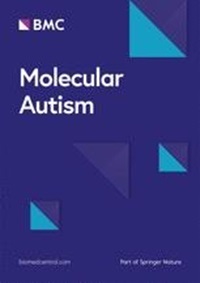基于任务的自闭症和精神分裂症谱系障碍社交认知的功能神经相关性
IF 6.3
1区 医学
Q1 GENETICS & HEREDITY
引用次数: 0
摘要
自闭症和精神分裂症谱系障碍(SSD)都具有不典型的社会认知特征。尽管有证据表明这两种疾病在低级情绪处理和高级心智化方面的表现具有可比性,但对这两种疾病的社会认知神经基础的研究却十分有限。我们的目标是比较自闭症患者、社会功能障碍患者和发育正常对照组(TDCs)的社会认知神经相关性。数据来自两项统一的研究,研究对象是被诊断为自闭症或 SSD 的患者和 TDCs(年龄在 16-35 岁之间),包括行为社会认知指标和两项功能磁共振成像(fMRI)任务:社会镜像模仿/观察(ImObs)任务和移情准确性(EA)任务。使用 FSL 的 PALM 对每项任务进行了组级比较,并结合社会认知表现进行了跨诊断分析,同时对年龄和性别进行了协变量分析(1000 次排列,阈值为 P < 0.05 FWE 校正)。此外,还进行了基于兴趣区域(ROI)的探索性分析。ImObs 和 EA 分析分别包括 164 和 174 名参与者(自闭症 N = 56/59,SSD N = 50/56,TDC N = 58/59)。各组的 EA 以及低级和高级社会认知得分均有所不同。虽然典型的社会认知网络被激活,但在这两项任务的神经相关性方面,均未发现明显的全脑或基于 ROI 的组间差异。从横向诊断的角度看,EA 任务中的神经活动与低级和高级社会认知表现相关,而 ImObs 任务中的神经活动与低级和高级社会认知表现无关。尽管我们试图在年龄、性别和种族上对各组进行匹配,但仍存在显著的组间差异。在全脑分析中,检测大脑区域差异的能力还受到样本大小和多重比较的影响。我们的研究结果可能无法推广到自闭症和并发智力障碍的 SSD 患者。在我们的样本中,没有发现全脑和基于 ROI 的群体水平差异,也没有观察到 EA 大脑与行为之间的维度关系,这表明 EA 任务可能非常适合用于新型干预测试中的目标参与。我们的研究结果还强调了跨条件方法在更好地理解自闭症和特殊障碍儿童的社会认知方面的潜在作用。本文章由计算机程序翻译,如有差异,请以英文原文为准。
Task-based functional neural correlates of social cognition across autism and schizophrenia spectrum disorders
Autism and schizophrenia spectrum disorders (SSDs) both feature atypical social cognition. Despite evidence for comparable group-level performance in lower-level emotion processing and higher-level mentalizing, limited research has examined the neural basis of social cognition across these conditions. Our goal was to compare the neural correlates of social cognition in autism, SSDs, and typically developing controls (TDCs). Data came from two harmonized studies in individuals diagnosed with autism or SSDs and TDCs (aged 16–35 years), including behavioral social cognitive metrics and two functional magnetic resonance imaging (fMRI) tasks: a social mirroring Imitate/Observe (ImObs) task and the Empathic Accuracy (EA) task. Group-level comparisons, and transdiagnostic analyses incorporating social cognitive performance, were run using FSL’s PALM for each task, covarying for age and sex (1000 permutations, thresholded at p < 0.05 FWE-corrected). Exploratory region of interest (ROI)-based analyses were also conducted. ImObs and EA analyses included 164 and 174 participants, respectively (autism N = 56/59, SSD N = 50/56, TDC N = 58/59). EA and both lower- and higher-level social cognition scores differed across groups. While canonical social cognitive networks were activated, no significant whole-brain or ROI-based group-level differences in neural correlates for either task were detected. Transdiagnostically, neural activity during the EA task, but not the ImObs task, was associated with lower- and higher-level social cognitive performance. Despite attempting to match our groups on age, sex, and race, significant group differences remained. Power to detect regional brain differences is also influenced by sample size and multiple comparisons in whole-brain analyses. Our findings may not generalize to autism and SSD individuals with co-occurring intellectual disabilities. The lack of whole-brain and ROI-based group-level differences identified and the dimensional EA brain-behavior relationship observed across our sample suggest that the EA task may be well-suited to target engagement in novel intervention testing. Our results also emphasize the potential utility of cross-condition approaches to better understand social cognition across autism and SSDs.
求助全文
通过发布文献求助,成功后即可免费获取论文全文。
去求助
来源期刊

Molecular Autism
GENETICS & HEREDITY-NEUROSCIENCES
CiteScore
12.10
自引率
1.60%
发文量
44
审稿时长
17 weeks
期刊介绍:
Molecular Autism is a peer-reviewed, open access journal that publishes high-quality basic, translational and clinical research that has relevance to the etiology, pathobiology, or treatment of autism and related neurodevelopmental conditions. Research that includes integration across levels is encouraged. Molecular Autism publishes empirical studies, reviews, and brief communications.
 求助内容:
求助内容: 应助结果提醒方式:
应助结果提醒方式:


